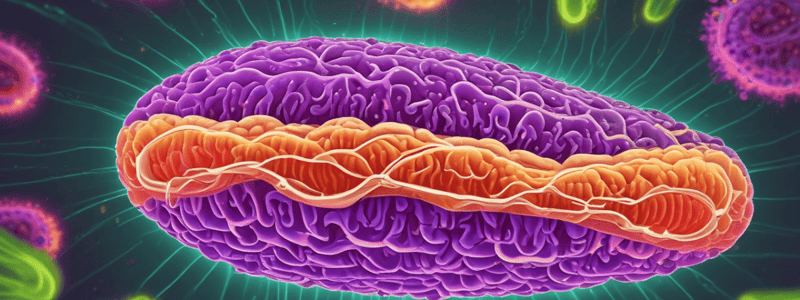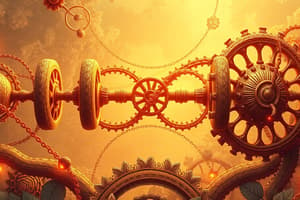Podcast
Questions and Answers
What is the purpose of the electron transfer in the process described?
What is the purpose of the electron transfer in the process described?
- To convert succinate to fumarate by having FAD accept two electrons from succinate
- To reduce two molecules of cytochrome c using two electrons from QH2
- To transport four protons through the Q cycle to the Inter Membrane Space
- To drive the expulsion of four protons per pair of electrons from the matrix (correct)
What is the role of Complex II (Succinate Dehydrogenase) in this process?
What is the role of Complex II (Succinate Dehydrogenase) in this process?
- It reduces two molecules of cytochrome c using two electrons from QH2
- It transports protons through the Q cycle to the Inter Membrane Space
- It does not transport protons as part of the process
- It accepts two electrons from succinate and passes them via iron-sulfur centers to ubiquinone (correct)
What is the role of Complex III (Ubiquinone:Cytochrome C Oxidoreductase) in this process?
What is the role of Complex III (Ubiquinone:Cytochrome C Oxidoreductase) in this process?
- It accepts electrons from succinate and passes them to ubiquinone
- It reduces two molecules of cytochrome c using two electrons from QH2 (correct)
- It does not transport protons as part of the process
- It transports four protons through the Q cycle to the Inter Membrane Space
What is the role of Cytochrome C in this process?
What is the role of Cytochrome C in this process?
How many electrons are carried by Cytochrome C in this process?
How many electrons are carried by Cytochrome C in this process?
What is the net result of the electron transfer process described?
What is the net result of the electron transfer process described?
What is the primary function of the cristae in mitochondria?
What is the primary function of the cristae in mitochondria?
Which of the following statements about the chemiosmotic mechanism in mitochondria is correct?
Which of the following statements about the chemiosmotic mechanism in mitochondria is correct?
Where are the enzymes involved in the citric acid cycle located within the mitochondrion?
Where are the enzymes involved in the citric acid cycle located within the mitochondrion?
What is the primary driving force for ATP synthesis in mitochondria?
What is the primary driving force for ATP synthesis in mitochondria?
Which of the following statements about the mitochondrial matrix is correct?
Which of the following statements about the mitochondrial matrix is correct?
What is the overall free-energy change (ΔG'o) for the transfer of electrons from NADH to O2?
What is the overall free-energy change (ΔG'o) for the transfer of electrons from NADH to O2?
What is the overall change in the redox potential (ΔE'o) for the transfer of electrons from NADH to O2?
What is the overall change in the redox potential (ΔE'o) for the transfer of electrons from NADH to O2?
How many protons are pumped out of the matrix into the intermembrane space for each electron pair transferred from NADH to O2?
How many protons are pumped out of the matrix into the intermembrane space for each electron pair transferred from NADH to O2?
What is the redox potential (E'o) for the O2/H2O redox pair?
What is the redox potential (E'o) for the O2/H2O redox pair?
What is the redox potential (E'o) for the NAD+/NADH redox pair?
What is the redox potential (E'o) for the NAD+/NADH redox pair?
What is the free-energy change (ΔG'o) for the transfer of electrons from succinate to O2?
What is the free-energy change (ΔG'o) for the transfer of electrons from succinate to O2?
What is the result of two electrons reducing one half oxygen molecule?
What is the result of two electrons reducing one half oxygen molecule?
How many protons are picked up from the matrix per four electrons in the process of reducing oxygen to water?
How many protons are picked up from the matrix per four electrons in the process of reducing oxygen to water?
What is the role of Complex IV (cytochrome oxidase) in the electron flow and proton movements in the respiratory chain?
What is the role of Complex IV (cytochrome oxidase) in the electron flow and proton movements in the respiratory chain?
What is the total number of protons that flow from the matrix to the intermembrane space when a pair of electrons flow through Complexes I, III, and IV?
What is the total number of protons that flow from the matrix to the intermembrane space when a pair of electrons flow through Complexes I, III, and IV?
Which electron carriers pass two electrons to Complex III in the electron transport chain?
Which electron carriers pass two electrons to Complex III in the electron transport chain?
How many protons are transferred to the intermembrane space when Complex IV transfers two electrons from reduced cytochrome c to half O2?
How many protons are transferred to the intermembrane space when Complex IV transfers two electrons from reduced cytochrome c to half O2?
Which of the following statements about electron carriers in the electron transport chain (ETC) is correct?
Which of the following statements about electron carriers in the electron transport chain (ETC) is correct?
What is the primary function of the electron transport chain (ETC) protein complexes?
What is the primary function of the electron transport chain (ETC) protein complexes?
Which of the following statements about the redox centers in the ETC protein complexes is incorrect?
Which of the following statements about the redox centers in the ETC protein complexes is incorrect?
What is the role of ubiquinone (coenzyme Q) in the electron transport chain?
What is the role of ubiquinone (coenzyme Q) in the electron transport chain?
Which of the following statements about the reduction of ubiquinone is correct?
Which of the following statements about the reduction of ubiquinone is correct?
What is the primary driving force for ATP synthesis in mitochondria?
What is the primary driving force for ATP synthesis in mitochondria?
Flashcards are hidden until you start studying



